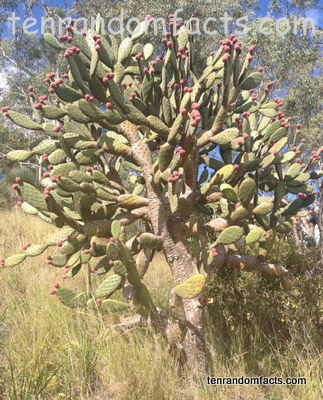Prickly monster.
- Prickly pear is also known as ‘nopal cactus’ and ‘paddle cactus’ and comes from the genus Opuntia which contains more than 150 species.
- Prickly pears are from the family Cactaceae, which is the family of cacti and are native to North and South America and some of the surrounding islands.
- Prickly pears have green, flat, oval shaped leaves called pads, that have long and short prickles that break off easily and irritate human skin.
- Prickly pears have become an invasive weed in parts of Africa, Australia and Europe, where they were introduced as ornamental plants, fences and barriers, and for stock feed.
- Prickly pears have edible fruit known as ‘cactus fruit’, ‘cactus fig’, ‘Indian fig’ and ‘tuna’, and are mainly red in colour, although other varieties include yellowy orange and green, and are high in Vitamin C.

- Cochineal, a scale insect, is a common pest on prickly pear plants, and the insects are collected to make a valuable red dye called cochineal, which is used to dye fabric, cosmetics, and food.
- The fruit and pads of prickly pears can be eaten, once the skin and prickles are removed, and the pads can be cooked like a vegetable and have been used in Mexican cooking for hundreds of years.
- In 1788, prickly pears were introduced in Australia for the purpose of producing cochineal to dye the red coats required for the British army, however, by the 1920s prickly pears had invaded 58 million acres (24 million hectares) of land, much of it good farming land, so the cactoblastis moth was introduced to control the cactus, and was so effective, that much of the land was reclaimed.
- The fruit of prickly pears are said to taste like a combination of bubblegum and watermelon, and can be made into candy, jam or beverages, or eaten raw, although some people do not like to eat the hard edible seeds.
- A prickly pear can be found on the Mexican coat of arms and is said to symbolise the hard times and difficulties that have passed and will come.




